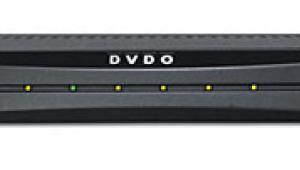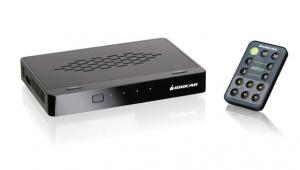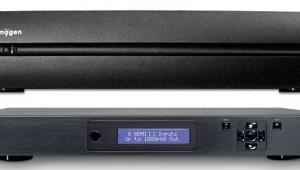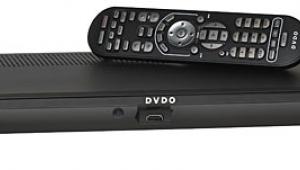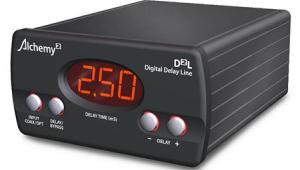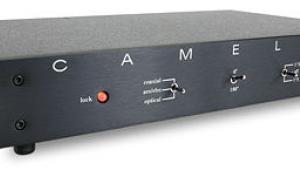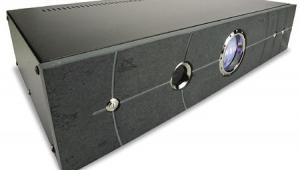Key Digital Systems HD Hanna Video Processor
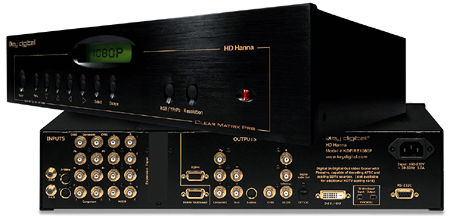
The HD Hanna (or, more accurately, the KD-FIRE1080P) is a slimmed-down version that more realistically addresses the world of microdisplay and flat-panel displays. It doesn't support every format under the sun, just the most common ones. It only upscales interlaced program material, after first deinterlacing it (unless an interlaced output is selected); 480p and 720p sources pass through it without processing. And a few goodies have been added to the mix, including an IEEE1394 (FireWire) interface and a built-in RF tuner that can receive both analog NTSC and digital ATSC signals.
Out of the Box
The HD Hanna fits the mold of a typical video scaler in appearance and size. It's finished in black and stands 2 rack units tall. The front panel is subtle, with a row of buttons and a small monochrome LCD display. Don't look for any power on/off or status indicator; there isn't one. Only the LCD display will give you an idea of Hanna's operating status and modes.
The rear panel is considerably simplified from earlier KDS scalers, which had rows and rows of color-coded BNC jacks for analog and digital audio and analog video connections. Hanna now sports a less intimidating connector complement that includes a pair of composite video inputs, two S-video jacks, BNCs for two component (YPbPr) video signals, and 2-channel analog audio for each input.
A separate expansion input can be configured to accept an RGB or DVI connection, which will work with computer or video sources. (Progressive-scan video and computer signals will pass through to the output.) A dedicated 15-pin RGB pass-through connector and two RF antenna connectors round out the inputs.
For outputs, you'll find a rack of BNCs that can function in YPbPr or RGBHV mode, a 15-pin VGA connector that duplicates these modes, and a pair of BNC jacks for audio. The audio output is simply an "audio follow" system; whichever input you've selected will have the corresponding audio switched to these two jacks.
A separate BNC output jack is labeled Digital Coaxial. This and the nearby TosLink optical digital audio connection are used to feed digital audio from digital TV stations you may tune in. There is no conversion of analog audio to digital in this scaler.
A DVI-D output runs in parallel to the analog video outputs, which means you can have both digital video and analog video feeds simultaneously. What's more, HD Hanna also provides a downconverted (SD) version, through an S-video connector (video) and a composite-video BNC jack (audio), of whatever signal you are currently watching.
Remote and Menus
The supplied remote control has "generic" written all over it. It has numerous small buttons of similar sizes, and it's not easy to operate without careful study. The manual does explain what the macro buttons do, but some of those have two labels—one below the button, which is the correct label, and one on the button itself, which is not correct.
For example, the blue macro button that's used to step through all available output resolutions has an "OR" label screened just below the button, but the button itself says "12V." The red button for toggling between YPbPr and RGB color spaces has a label of "SR" on it. (The manual tells you to ignore the incorrect nomenclature, but I still got confused from time to time with these buttons.)
The center of the remote features four directional arrows and a large OK (Enter) button. The up/down arrows are also used for channel changing, although there's no indication of this on the remote. Separate buttons provide access to the setup and operating menus, input signal, and aspect ratio (there are five to choose from). A gray button marked "DSX" on its surface is actually used to identify a digital TV station.
You can also select a particular TV channel by using the numeric keypad, though the correct RF input (A or B) receiving that signal must be selected. There is no way to toggle between antennas A and B from the remote—you must go into the menu to make the change, which is a bit of a nuisance. Oddly, I found that some channels only receivable through Antenna A could be tuned in while Antenna B was selected, but others only on A could not.
The menus are far simpler than in older KDS scalers. The first menu lets you select antenna inputs, scan for channels, edit your channel list, check signal strength, and check for an electronic program guide. The tuner will accept analog NTSC and digital ATSC signals through either input, but it takes a long time to scan for them.
Hooking up an outdoor antenna, I initiated a channel scan on the Antenna A input and had to wait four minutes while HD Hanna did two complete scans; the first was from channel 2 through 69, and the second from channel 2 through 130. Apparently there is no way to tell the device that the connection is off-air or cable.
- Log in or register to post comments
